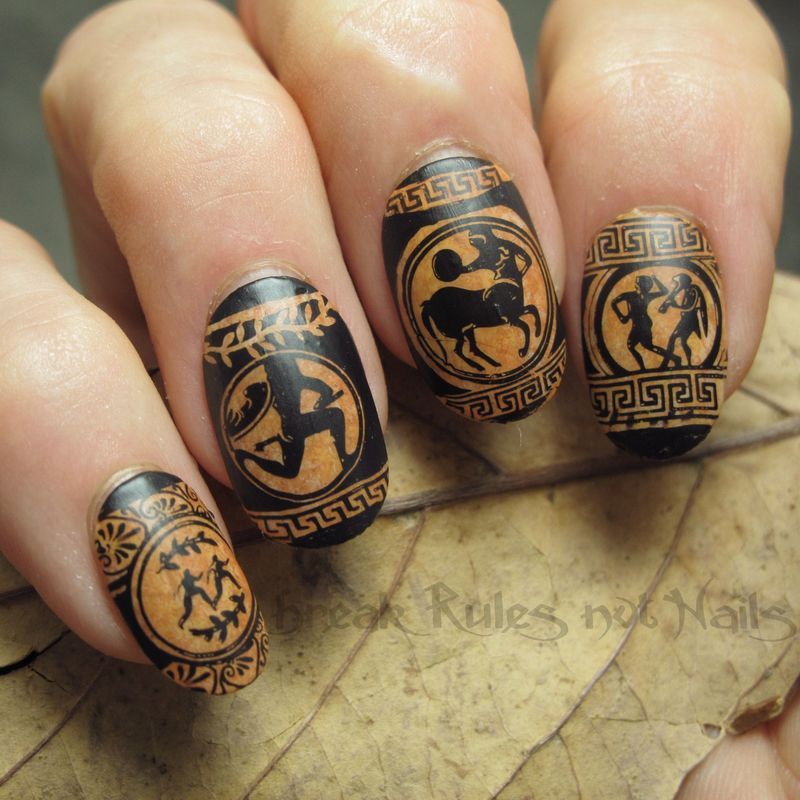Naukratis (Ναύκρατις, meaning 'naval victory) was a city of Ancient Egypt, on the Canopic branch of the Nile river, 45 mi (72 km) South East of the open sea and the later capital of Ptolemaic Egypt, Alexandria. It was the first and, for much of its early history, the only permanent Hellenic colony in Egypt; acting as a symbiotic nexus for the interchange of Hellenic and Egyptian art and culture.
The modern site of the city has become an archaeological find of the highest significance and the source of not only many beautiful objects of art now gracing the museums of the world but also an important source of some of the earliest Hellenic writing in existence, provided by the inscriptions on its pottery.
According to the Classical historian Herodotos, in the mid-sixth century BC the Egyptian Pharaoh Amasis gave the town of Naukratis to Hellenes from twelve different cities to live in, including land where non-resident traders could erect sanctuaries. However, archaeology attests the site’s existence already under Pharaoh Psammetichus (Psamtek) I, from at least 620/610 BC. Furthermore, Naukratis was not just a Hellenic but also an Egyptian town, in which Hellenes and Egyptians lived side by side for centuries. To Egyptians, the site was known as Nokradj (the Hellenic name ‘Naukratis’ deriving from this Egyptian name), or as Per-Meryt, the-House-of-the-Harbour. The city had close connections to the Egyptian royal city Sais, located on the neighbouring branch of the Nile.
Naukratis was frequented by traders from many Hellenic cities as well as by Phoenicians and Cypriots; it became famous for its elaborate symposia (dining parties) and beautiful hetairai (courtesans). Naukratis functioned as the main trading port in the Western Nile Delta until the foundation of Alexandria, and continued to be significant also throughout the Hellenistic and Roman periods. Officers (prostatai) appointed by the nine founding cities of the Hellenion administered the emporion (Hellenic trading post) at least from the time of Amasis. Imports into Egypt included wine, oil, and silver, and exports from Egypt grain, flax, natron, papyrus, perfume and other semi-luxuries.
The modern site of the city has become an archaeological find of the highest significance and the source of not only many beautiful objects of art now gracing the museums of the world but also an important source of some of the earliest Hellenic writing in existence, provided by the inscriptions on its pottery.
According to the Classical historian Herodotos, in the mid-sixth century BC the Egyptian Pharaoh Amasis gave the town of Naukratis to Hellenes from twelve different cities to live in, including land where non-resident traders could erect sanctuaries. However, archaeology attests the site’s existence already under Pharaoh Psammetichus (Psamtek) I, from at least 620/610 BC. Furthermore, Naukratis was not just a Hellenic but also an Egyptian town, in which Hellenes and Egyptians lived side by side for centuries. To Egyptians, the site was known as Nokradj (the Hellenic name ‘Naukratis’ deriving from this Egyptian name), or as Per-Meryt, the-House-of-the-Harbour. The city had close connections to the Egyptian royal city Sais, located on the neighbouring branch of the Nile.
Naukratis was frequented by traders from many Hellenic cities as well as by Phoenicians and Cypriots; it became famous for its elaborate symposia (dining parties) and beautiful hetairai (courtesans). Naukratis functioned as the main trading port in the Western Nile Delta until the foundation of Alexandria, and continued to be significant also throughout the Hellenistic and Roman periods. Officers (prostatai) appointed by the nine founding cities of the Hellenion administered the emporion (Hellenic trading post) at least from the time of Amasis. Imports into Egypt included wine, oil, and silver, and exports from Egypt grain, flax, natron, papyrus, perfume and other semi-luxuries.
During the Hellenistic period Naukratis was one of three Hellenic poleis (city-states) in Egypt and remained an important town and regional hub. Alexander the Great’s finance minister, Kleomenes, was born here. In the late fourth century BC Naukratis briefly issued its own bronze coinage.
Artefacts dating from the late first century BC to the seventh century AD show that Naukratis continued to be occupied well into the Roman period and beyond. The settlement had shrunk into a town by the second century AD, though it retained some status. Games, featuring poetry competitions, apparently continued to be performed there into the third century AD, and the site was home to the famous culinary writer Athenaeus. Byzantine period (AD 330 to 641) artefacts, sometimes displaying Christian symbols, are rare, and it seems that by the seventh century AD Naukratis had fallen into obscurity.
For more information about the city and images of many of the artifacts found, visit the website of the British Museum.
Artefacts dating from the late first century BC to the seventh century AD show that Naukratis continued to be occupied well into the Roman period and beyond. The settlement had shrunk into a town by the second century AD, though it retained some status. Games, featuring poetry competitions, apparently continued to be performed there into the third century AD, and the site was home to the famous culinary writer Athenaeus. Byzantine period (AD 330 to 641) artefacts, sometimes displaying Christian symbols, are rare, and it seems that by the seventh century AD Naukratis had fallen into obscurity.
For more information about the city and images of many of the artifacts found, visit the website of the British Museum.
-
Thursday, December 31, 2015
Ancient Cities Collection ancient Hellenic culture archeology herodotos Naukratis











